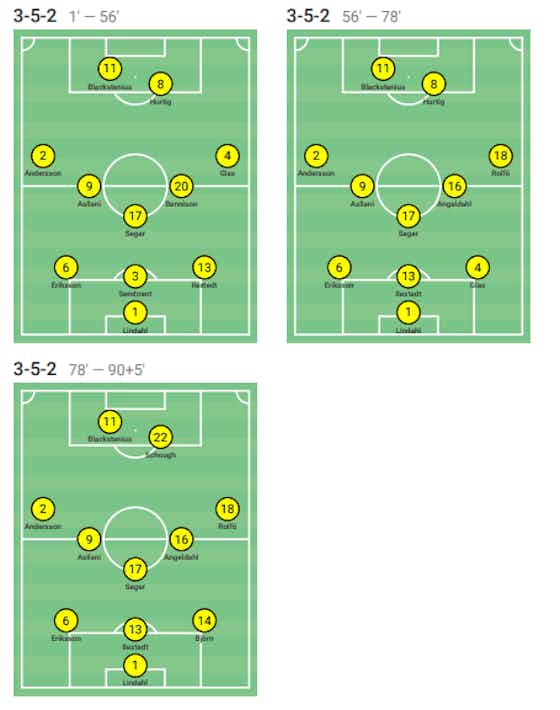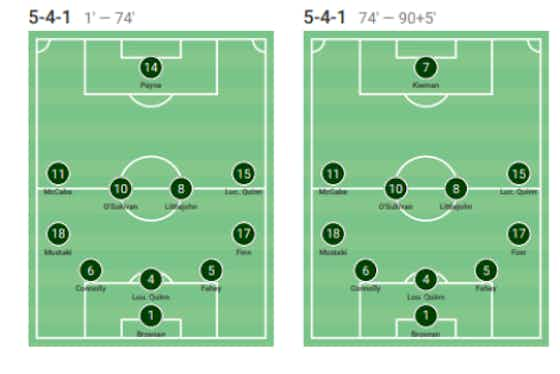Her Football Hub
·17 April 2022
Analysis: How Ireland managed to stop Sweden from winning

Her Football Hub
·17 April 2022

Sweden recently announced their jerseys for the 2022 Euros. The shirts were released with a detailed analysis on how to stop the European top team. The next opponent after that was Ireland, could the Irish side take advantage of that detailed analysis?
Written by Sweden’s match analyst Anders Eriksson, the guide contains an overview of the team’s style of play. In addition, it features detailed profiles of the players, which highlight their strengths. Eriksson’s article also gives exact advice to Sweden’s opponents on how to prevent the side from scoring and how to break down their defence.
This analysis focuses on the disruption of Swedish attacking moments by Ireland. Both sides met in Gothenburg earlier for a decisive World Cup qualifier. Ireland impressed with their performance, as they held the highest-ranked team in Europe down to a 1-1 draw.

Source: Wyscout
Sweden approached the important qualifier with a 3-5-2 system. The experienced back-three was supported by two additional defenders on the wings. These wingbacks are vital in both attack and defence.
They had the task to initiate dangerous attacks with their long balls and fast runs forward. In midfield, Caroline Seger took up a more defensive role and directed her team’s shape as a playmaker.
Meanwhile, Kosovare Asllani posed additional attacking threats with her dynamics and speed. She created several dangerous shots and passes into the penalty area from the center.

Source: Wyscout
The Irish side had a much more defensive tactic in mind. Playing in a 5-4-1 formation, they gave Sweden’s formidable offense a hard time by playing compact and with two strong defensive lines.
Starting with five defenders allowed Ireland to press the Swedish players in pairs. This also enabled them to effectively close down any space between their backline and penalty area that Sweden could have used for an attack.
Putting only one striker up top didn’t weaken the Irish side’s offense. In midfield, they were stacked with dangerous players, who constantly sought the way forward, while maintaining defensive stability. These players were vital in the transition from defence to attack, and therefore could still pose a threat in attack.
“The team excels in threatening and attacking from wide areas and break inside with speed and power, consistently looking to cross the ball into the box. On that account, (…), try to force the Swedish players toward the sidelines and close them down aggressively.” – HowToStopSweden.com
Ireland’s reaction to an attempted attack from Sweden in the 13th minute gives an example of how the Girls in Green applied the guide’s advice.
Source: Wyscout
Here, we see Hanna Bennison trying to find Kosovare Asllani in the middle. However, she was closed down by three Irish players. Therefore, Bennison made the pass to RWB Hanna Glas, who was able to forward the ball to Asllani.
However, the moment she got the ball, Katie McCabe started chasing her aggressively towards the sideline and away from the center.
Asllani “continually [sets] up her teammates inside the penalty area with dangerous passes from central spaces (…) and half-spaces (….)“, as Anders Eriksson emphasizes.
As McCabe pressed the midfielder, she follows the analyst‘s advice to „make [her] play facing her own goal and avoid 1-on-1 challenges with [the] center backs.
Source: Wyscout
Pushed away from her preferred position at the center, Asllani made the pass back to Glas. Normally, the defender would then use her outstanding speed and attempt a cross into the penalty area. However, two Irish players pushed her to the edge and kept her there.
With this, they follow another piece of advice from Anders Eriksson. He suggests „to approach her 2-on-1 when attacking for a higher success ratio.“
As a result, Glas had to play the ball back to Asllani.
Source: Wyscout
Back at the center, the midfielder’s options were limited. An Irish defender marked Glas, while Asllani herself was put under pressure by McCabe. Other support players, such as Bennison and Lina Hurtig were closed down, as Ireland left no space for passes into their penalty area.
Finally, Asllani had to make a pass back to RCB Amanda Ilestedt.
„Sweden has an impressive 35% shot ratio on set plays. So make sure to close down running lanes and slow down Sweden’s attackers during corners and free kicks.“ – HowToStopSweden.com
Throughout the game, Sweden won a total amount of five corners. When defending these, Ireland brought as many players into the six-yards box as possible.
Source: Wyscout
As LWB Jonna Andersson executed the corner, Ireland had eight outfield players protecting their goal. Two more guard Sweden‘s offensive midfielders at the edge of the penalty area.
One of the home side’s most dangerous players in the air is forward Lina Hurtig. Therefore, Anders Eriksson advised Sweden’s opponents to “stop any high crosses from Swedish wide players aimed at [her] close to the goal.“
Hurtig is guarded 1 on 1 by Ireland’s Louise Quinn, who did not let her near the goal line. Instead, she kept the Swede out of the six-yard box and away from Andersson’s inswinging corner kick.
Source: Wyscout
In addition, having eight players in the penalty area during the set piece allows Ireland to close down any space in front of the goal, which the Swedish strikers could have used for a shot on target.
Again, attacking midfielders Filippa Angeldahl and Kosovare Asllani were prevented from reaching the ball in the penalty area by their defenders. The Manchester City player, according to Anders Eriksson, “likes to drive the ball with speed into the space between the opponent lines.”
However, she posed no threat being marked by the Irish player in the situation above. Apart from closing down the channels towards the goal, Ireland again made sure that none of the Swedish strikers got hold of the ball.
The Girls in Green overloaded Sweden by five/six to eight players in the penalty area during corner kicks. This allowed them to mark the opponents and find a way to clear the ball at the same time.
The selected scenes from the game have shown that Ireland did pay attention on the things described in the guide on how to stop Sweden carefully. They managed to slow down a very dynamic Swedish side, which is stacked with dangerous players.
Throughout the game, Ireland managed to keep their defensive shape and limit Sweden to only four shots on target. All in all, it was an impressive performance by the Irish players.






























































